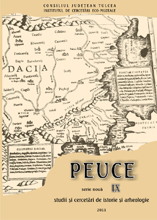Ceramica din siturile culturii Babadag. Cu privire specială asupra descoperirilor din Dobrogea
Pottery from the Babadag culture sites. Special focus on finds in Dobrudja
Author(s): Sorin Cristian AilincăiSubject(s): Archaeology
Published by: Institutul de Cercetari Eco-Muzeale Tulcea - Institutul de Istorie si Arheologie
Keywords: Early Iron Age; Babadag culture; pottery; prima epocă a fierului; cultura Babadag; ceramică
Summary/Abstract: In our endeavor, we have identified 10 categories of pottery, noted with letters from A to J, which are also classified in 33 subcategories and 110 types differentiated especially based on whole or graphically reconstructed vessels. Undoubtedly, the typological repertoire of Babadag culture pottery is much ampler, and our typology may be subject to significant extension. After processing exhaustive lots of materials from the settlements at Enisala–Palanca, Garvăn–Mlăjitul Florilor, Jijila–Cetăţuie, Niculiţel–Cornet, we obtained certain data regarding the frequency of the categories and subcategories of pottery that we have established. Amongst them, the majority was pottery under letters A (amphorae), C (cups), E (bowls) and F (coarse ware), used especially for storing/ transporting liquid or solid products or as kitchenware, while the other categories are usually underrepresented in the analyzed lots. This analysis provided us with the opportunity to observe the types of pattern and the frequency of decoration on certain types of vessels. Even though the pottery was analyzed according to S. Morintz’s delimitations and observations for the 2nd and 3rd phase of Babadag culture, we can consider that the decorations used in this in the entire areal of Babadag culture are relatively unitary, and the differences are most likely due to the distinctions in investigating and publishing the materials. Thus we can say that none of S. Morintz’s criteria based on stylistic characteristics can hold ground against the study of a numerous lot of materials analyzed exclusively according to the context of the find (and not to the stylistic elements). The three main decoration techniques coexist and seem to be associated rather with certain types of vessels than to chronological landmarks. Rezumat: În prezentul studiu sunt definite 10 categorii ceramice, notate cu litere de la A la J, acestea fiind împărţite la rândul lor în 33 de subcategorii şi 110 tipuri, diferenţiate mai ales pe baza recipientelor întregi sau întregibile grafic. Fără îndoială, repertoriul tipologic al ceramicii culturii Babadag este mult mai vast, iar schema noastră se pretează unei lărgiri considerabile. Prelucrarea unor loturi exhaustive de materiale provenite din aşezările de la Enisala–Palanca, Garvăn–Mlăjitul Florilor, Jijila–Cetăţuie, Niculiţel–Cornet ne-a oferit ocazia să obţinem unele date referitoare la frecvenţa categoriilor şi subcategoriilor ceramice diferenţiate de noi. Dintre acestea, predominante sunt cele notate cu A (vase bitronconice), C (ceşti), E (străchini) şi F (vase borcan sau sac) folosite mai ales pentru depozitarea/transportul produselor lichide sau solide, ca veselă sau pentru gătit, celelalte categorii reprezentând de obicei ponderi foarte mici în cadrul loturilor analizate. În acelaşi timp, acest studiu ne-a permis să observăm tipurile de decor şi frecvenţa decorării unor anumite tipuri de recipiente. Deşi materialul ceramic a fost analizat ţinând cont
Journal: Peuce (Serie Nouă) - Studii şi cercetari de istorie şi arheologie
- Issue Year: IX/2011
- Issue No: 9
- Page Range: 55-178
- Page Count: 99
- Language: Romanian

